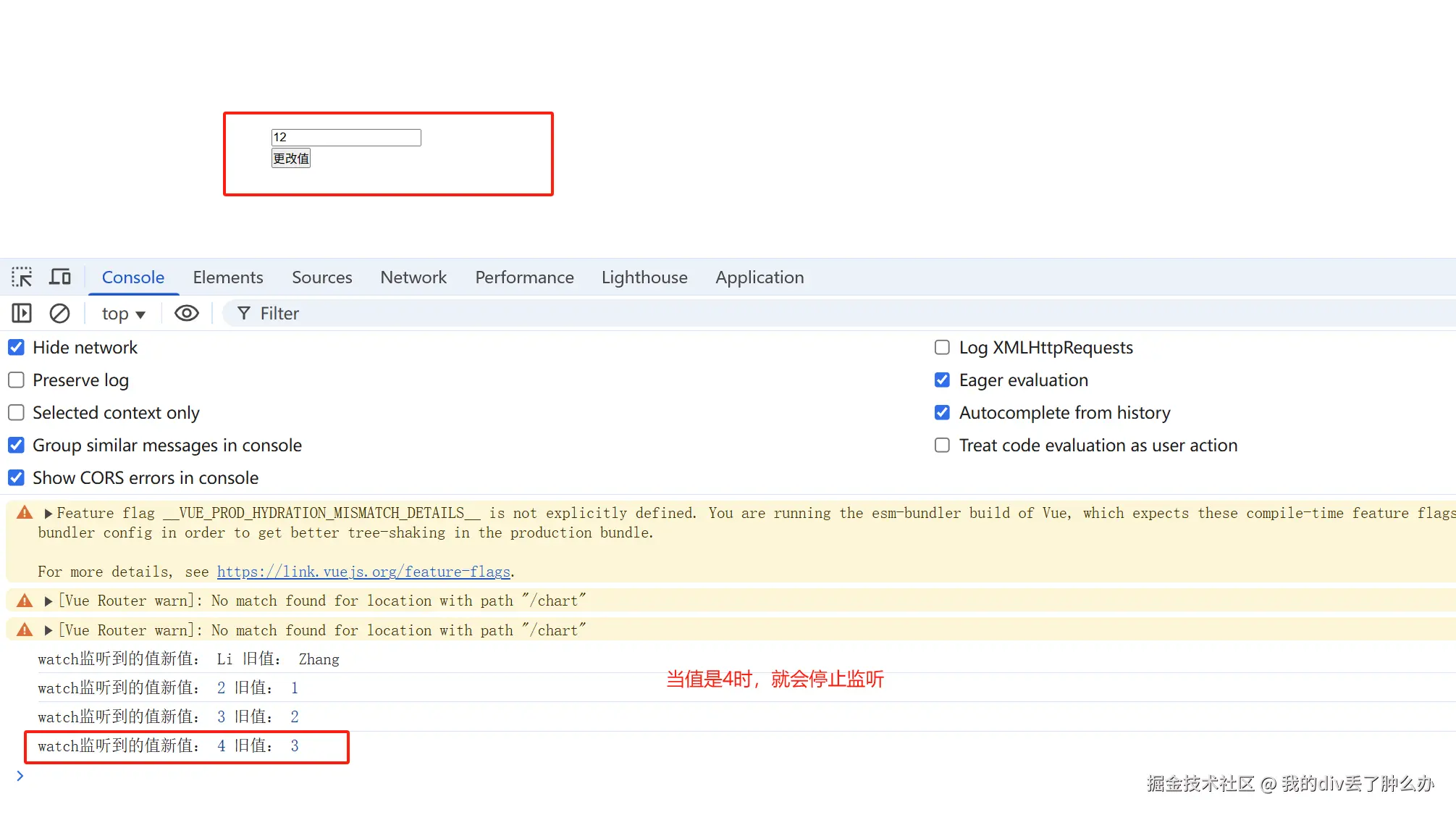Vue3 中的 watch 只能监视以下四种数据
1,ref 定义的数据。 2,reactive 定义的数据。
3,函数的返回一个值(getter函数)。getter函数其实就是:能返回一个值的函数
4,由以上类型的值组成的数组
地址:cn.vuejs.org/api/reactiv... 
vue3中watch监听 ref定义的基本数据类型
xml
<template>
<div class="box">
姓 <input v-model="xingValue" /> <br>
<button @click="changeHandler">更改值</button>
</div>
</template>
<script setup lang="ts">
import { ref, computed, watch } from 'vue';
const xingValue = ref('Zhang');
function changeHandler(){
xingValue.value = 'Li';
}
watch(xingValue, (newValue,oldValue)=>{
console.log('watch监听到的值新值:',newValue,'旧值:', oldValue)
})
</script>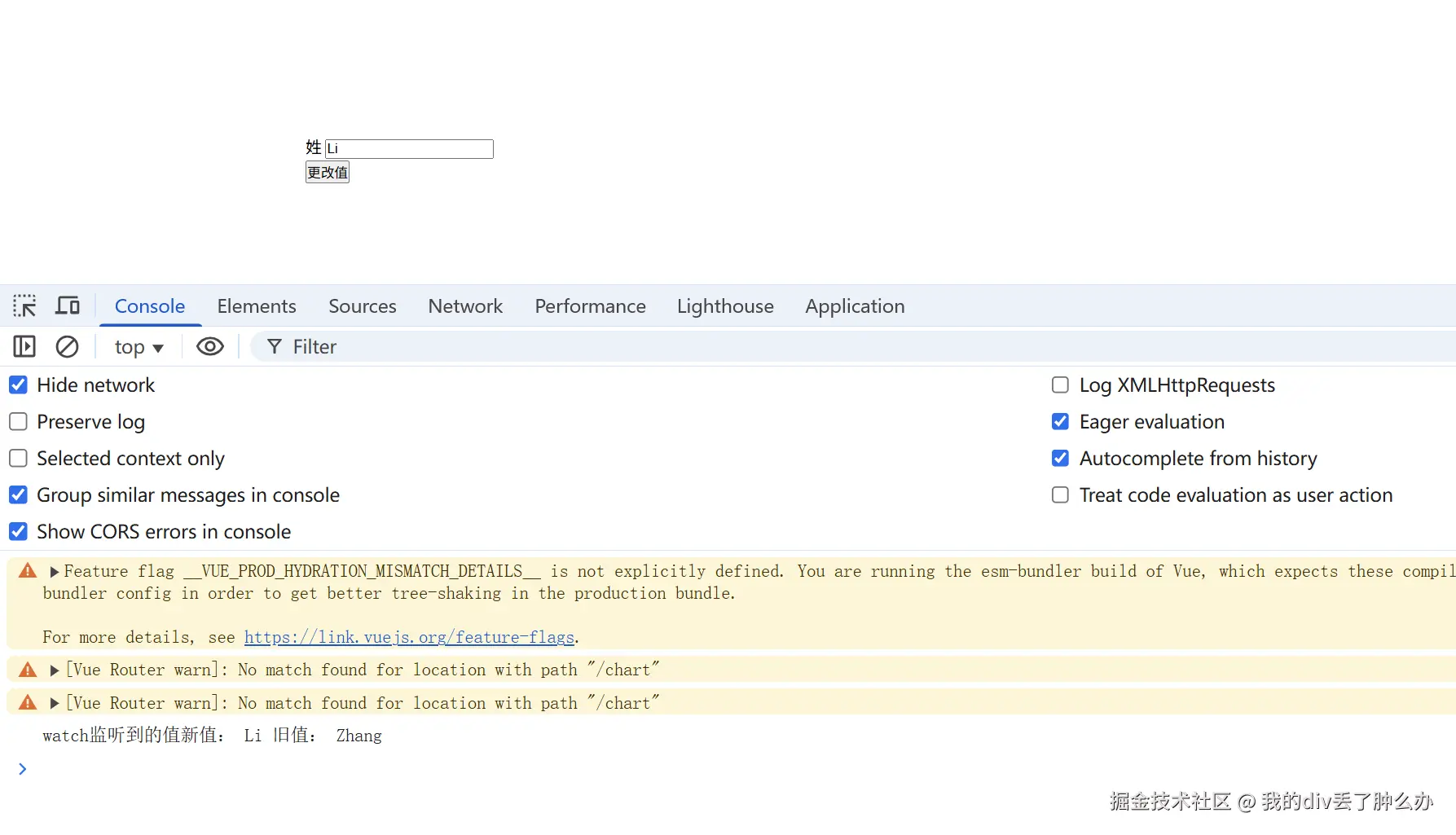
watch监听ref声明的数据,第1个参数是不需要点value
如果我们使用watch监听ref声明的数据,第1个参数是不需要点value的。
javascript
const age = ref(1);
// watch监听ref声明的数据,第1个参数是不需要点value
watch(age, (newValue,oldValue)=>{
console.log('watch监听到的值新值:',newValue,'旧值:', oldValue)
})如果你使用ref声明的数据,如果你使用了点value。那么会报错的哈。 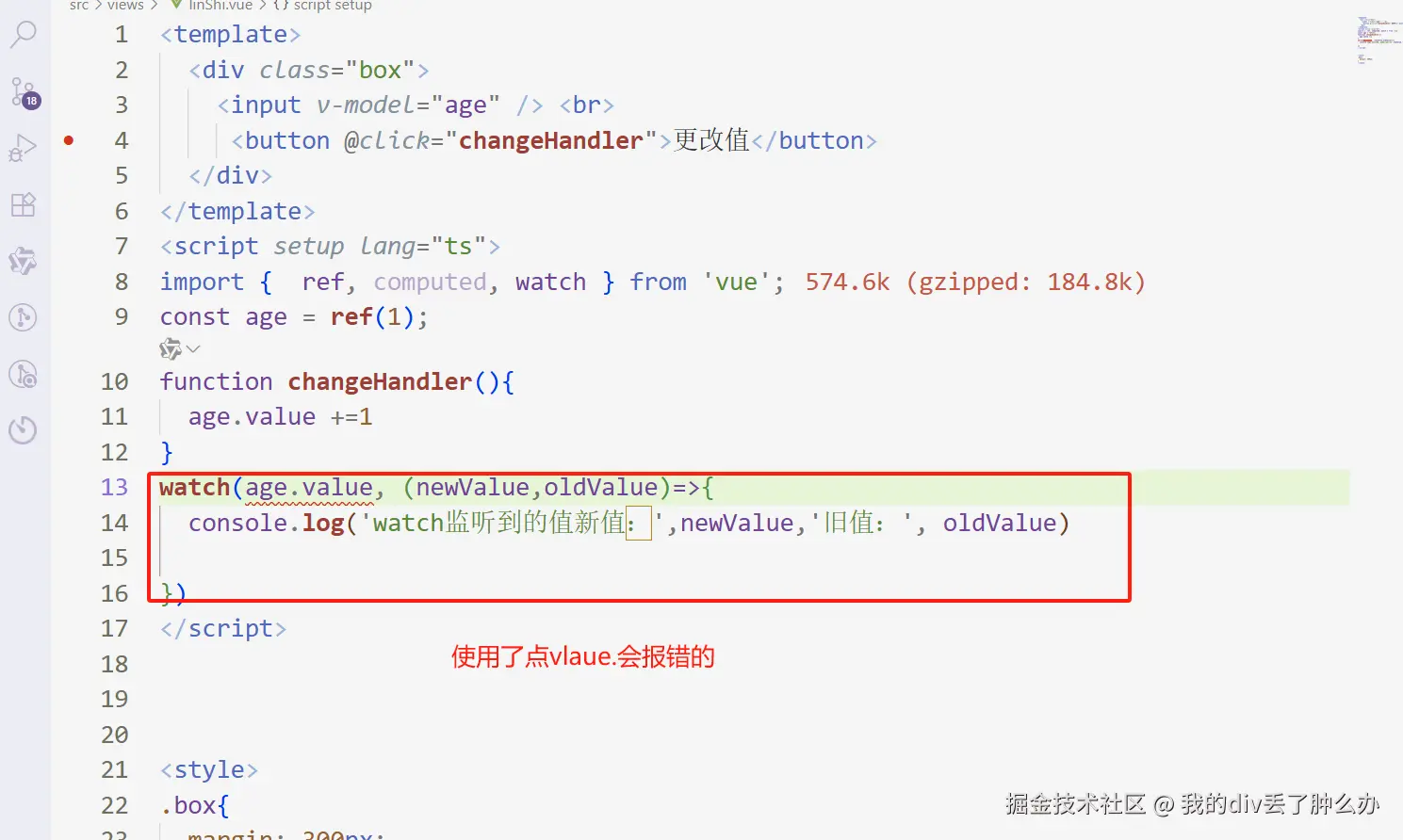
watch监听ref定义的对象数据类型
watch监听ref定义的【对象】数据类型时,监听的是对象的地址。
若是想要监听【对象内部属】性的变化,也就是细枝末节的变化。首要手动开启deep:true。
若是不开启deep:true,则监听不到。
watch监听ref定义的【对象】数据类型时,若是不开启deep:true,则监听不到对象内部属性的变化。
xml
<template>
<div class="box">
<p>{{ perosn }}</p>
<button @click="changeHandler">更改值</button>
</div>
</template>
<script setup lang="ts">
import { ref, computed, watch } from 'vue';
const perosn = ref({
name: 'zhangsan',
age: 18
});
function changeHandler(){
perosn.value.age+=1
}
watch(perosn, (newValue,oldValue)=>{
console.log('watch监听到的值新值:',newValue,'旧值:', oldValue)
})
</script>为啥更改ref定义的【对象】的属性时不会触发。
因为:watch监听ref定义的【对象】数据类型时,监听的是对象的地址。
地址没有发生改变,因此就不会触发。
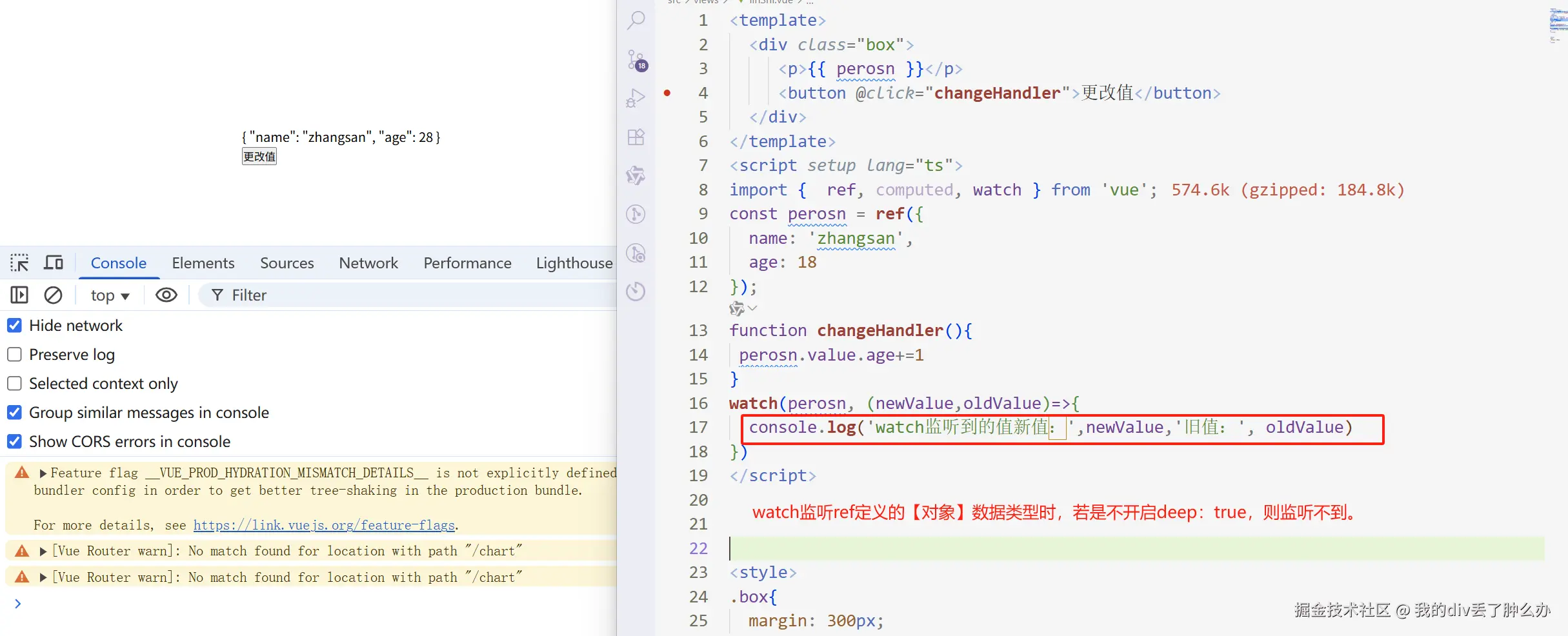 如果想要:地址不发生改变时,也触发 ,需要开启:deep:true
如果想要:地址不发生改变时,也触发 ,需要开启:deep:true
watch开启deep:true监听ref对象内部属性的变化
watch开启deep:true监听ref对象内部属性的变化
xml
<template>
<div class="box">
<p>{{ perosn }}</p>
<button @click="changeHandler">更改值</button>
</div>
</template>
<script setup lang="ts">
import { ref, computed, watch } from 'vue';
const perosn = ref({
name: 'zhangsan',
age: 18
});
function changeHandler(){
perosn.value.age+=1
}
watch(perosn, (newValue,oldValue)=>{
console.log('watch监听到的值新值:',newValue,'旧值:', oldValue)
},{
deep: true
})
</script>
watch监听ref定义的对象内部属性变化时,开启deep:true 新值和旧值是一样的
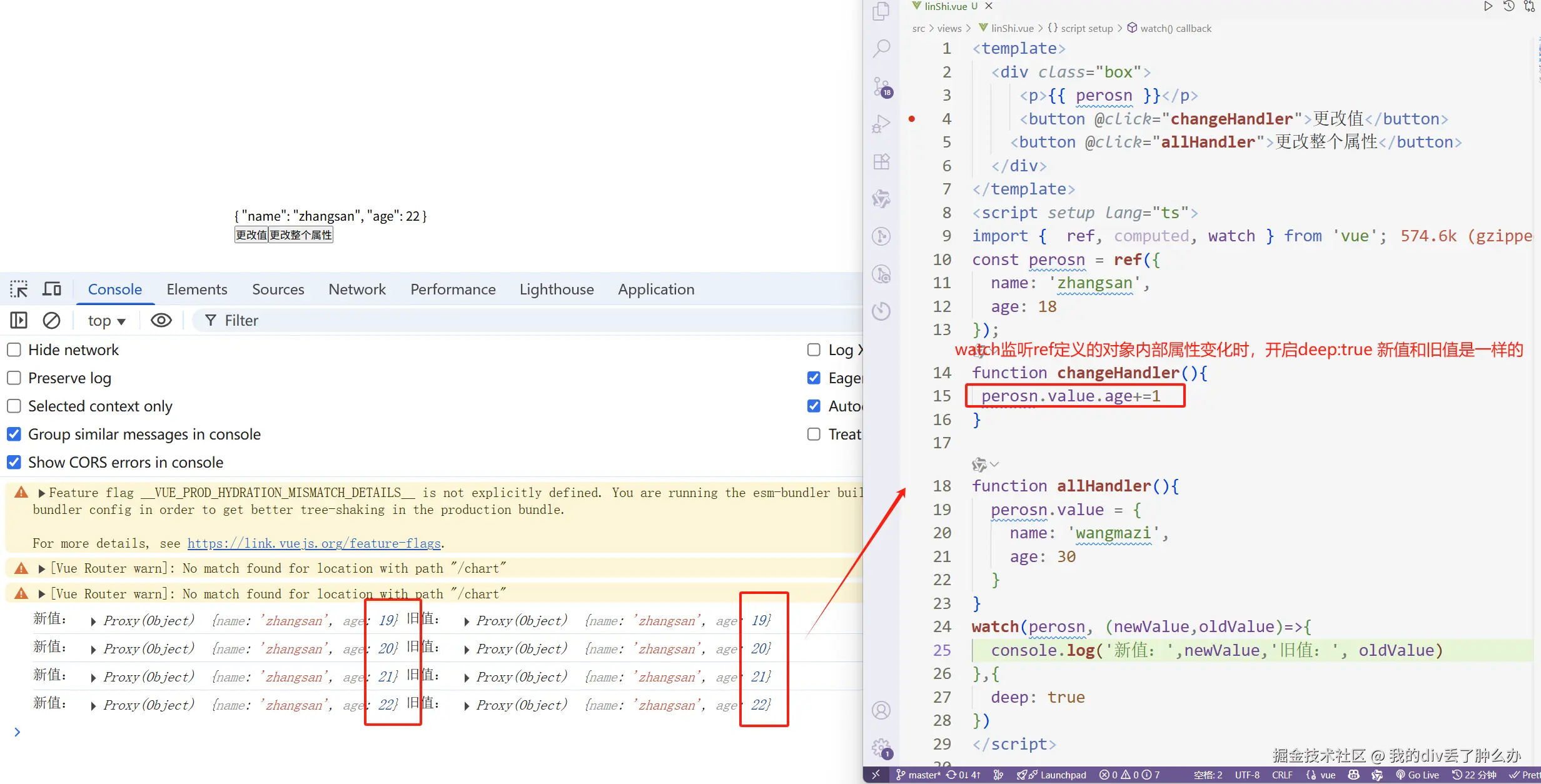 因为:watch监听ref定义的【对象】数据类型时,监听的是对象的地址。他们的地址是没有发生改变的。
因为:watch监听ref定义的【对象】数据类型时,监听的是对象的地址。他们的地址是没有发生改变的。
watch监听ref定义的对象时,修改整个对象,newValue 和 oldValue 是不一样的
xml
<template>
<div class="box">
<p>{{ perosn }}</p>
<button @click="allHandler">更改整个属性</button>
</div>
</template>
<script setup lang="ts">
import { ref, computed, watch } from 'vue';
const perosn = ref({
name: 'zhangsan',
age: 18
});
function allHandler(){
// 若修改整个ref 定义的对象,这个时候地址发生变化了。
// 如果你多次点击,会多次触发。
perosn.value = {
name: 'wangmazi',
age: 30
}
}
watch(perosn, (newValue,oldValue)=>{
console.log('新值:',newValue,'旧值:', oldValue)
},{
deep: true
})
</script>
总结:watch监听ref声明对象类型的数据时
watch监视 ref 定义的【对象类型】数据时,直接写数据名,监视的是对象的【地址值】
若想监视对象内部的数据,要手动开启深度监视
若修改的是 ref 定义的对象中的属性,newValue 和 oldValue 都是新值,因为它们是同一个对象。
若修改整个ref 定义的对象,newValue 是新值, oldValue 是旧值,因为不是同一个对象了

watch监视【reactive】定义的【对象类型数据】,默认是开启深度监视的
只要我们使用watch去监听reactive定义的对象类型数据
无论数据层级有多么深,watch都是可以监听到的,并且它默认是开启了深度监听的。
无论内部变化的是某个属性,还是对象,都可以监听到。
监听这种是最省心的,因为无论怎么变化,都是可以监听到的哈哈。
xml
<template>
<div>
<h1>{{ person }}</h1>
<button @click="allHandler">更改car这个对象</button>
<button @click="oneNameHandler">更改某个属性name</button>
</div>
</template>
<script lang="ts" setup>
import { watch,reactive } from 'vue';
const person = reactive({
age:18,
name:'张三',
car:{
c1:'电动车',
c2:'燃油车'
}
});
function allHandler(){
person.car = {
c1:'小米',
c2:'Su7'
}
}
function oneNameHandler(){
person.name = '李四';
}
// watch监视【reactive】定义的【对象类型数据】,默认是开启深度监视的
// 无论内部变化的是某个属性,还是对象,都可以监听到。
watch(person, (newValue,oldValue)=>{
console.log('新值:',newValue)
console.log('旧值:', oldValue)
})
</script>
有的文章会说:这种深度监听你是无法通过deep:false来进行关闭的。
这种说法不太正确,在现在的vue3.5版本中。
通过deep:false是可以关闭监听的。
xml
<template>
<div class="box">
<p>{{ person }}</p>
<button @click="allHandler">更改整个属性</button>
</div>
</template>
<script setup lang="ts">
import { ref, computed, watch, reactive } from 'vue';
const person = reactive({
a:{
b:{
c: 1
}
}
});
function allHandler(){
person.a.b.c +=1
}
watch(person, (newValue,oldValue)=>{
console.log('新值:',newValue,'旧值:', oldValue)
},{
deep: false,
})
</script>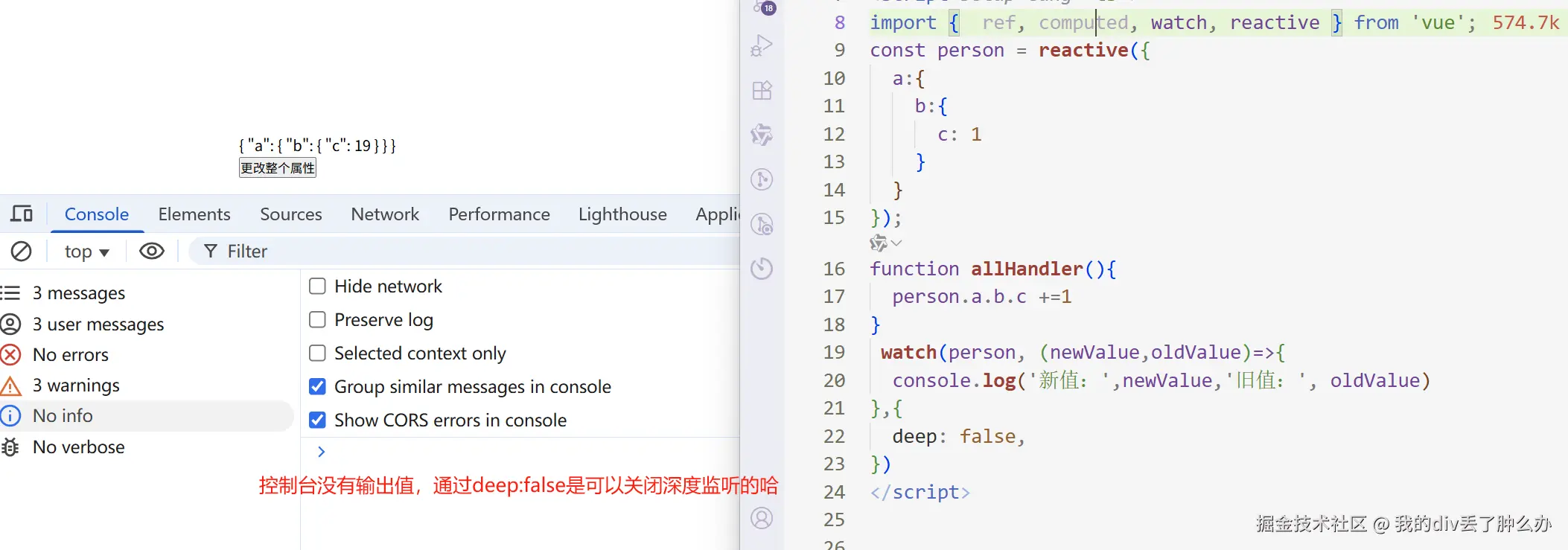
watch监视 ref 或 reactive定义的【对象类型】数据中的某个属性
watch监视 ref 或 reactive定义的【对象类型】数据中的某个属性,注意点如下:
1,若该属性值是【对象类型】,可直接写数据源,也可写成函数(建议写成函数)。并且推荐开启深度监听。
2,若该属性值不是【对象类型】,需要写成函数形式。否则会在控制台产生告警。
若该属性值不是【对象类型】,需要写成函数形式
xml
<template>
<div class="box">
<p>{{ person }}</p>
<button @click="allHandler">更改整个属性</button>
</div>
</template>
<script setup lang="ts">
import { ref, computed, watch, reactive } from 'vue';
const person = reactive({
age:18,
name:'张三',
car:{
c1:'电动车',
c2:'燃油车'
}
});
function allHandler(){
person.age+=1
}
// 监听person.age属性,会产生警告。
watch(person.age, (newValue,oldValue)=>{
console.log('新值:',newValue,'旧值:', oldValue)
})
</script>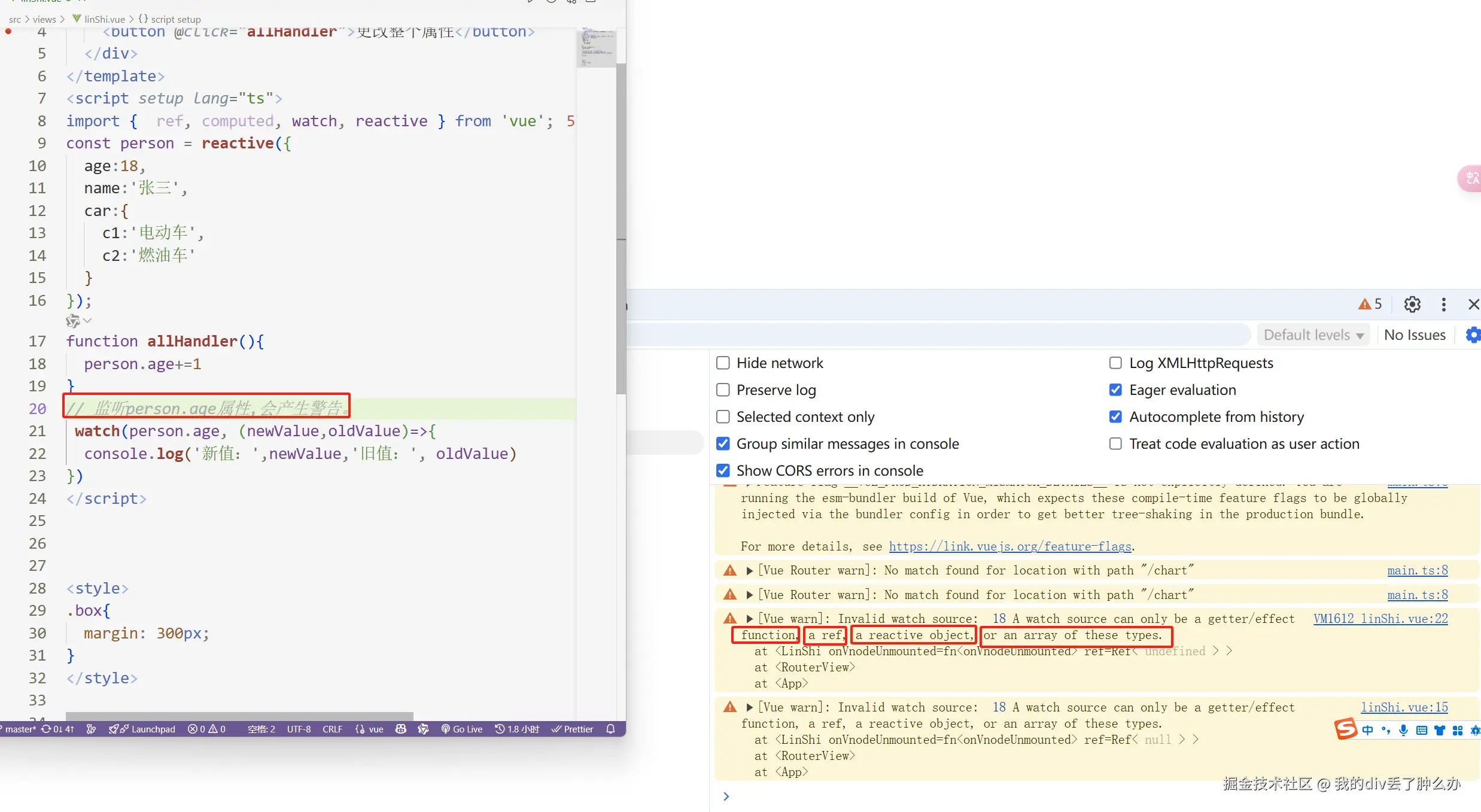
php
const person = ref({
age:18,
name:'张三',
car:{
c1:'电动车',
c2:'燃油车'
}
});
watch(person.value.name, (newValue,oldValue)=>{
console.log('newValue', newValue)
console.log('oldValue', oldValue)
})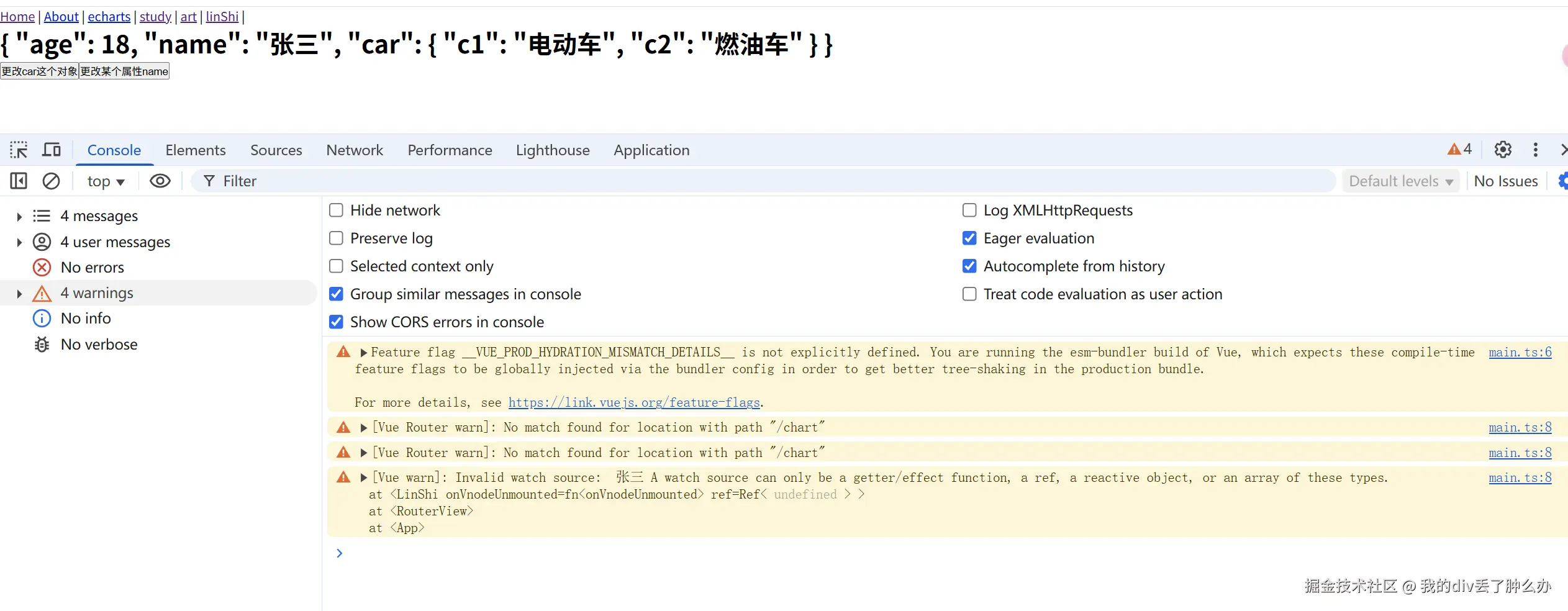
现在有警告。为啥会警告。
因为:watch监视 ref 或 reactive定义的【对象类型】数据中的某个属性时。
如果这个属性值不是对象类型时,需要写成函数形式。【重点】
javascript
// 因为这个属性值不是对象类型时,所以写成了函数形式
watch(()=> person.age, (newValue,oldValue)=>{
console.log('新值:',newValue,'旧值:', oldValue)
})
watch监听reactive定义的对象,监听的属性是对象(写成数据源形式),你替换整个对象,监听不到。
xml
<template>
<div class="box">
<p>{{ person }}</p>
<button @click="allOneHandler">更改某个属性</button>
<button @click="allHandler">更改整个对象</button>
</div>
</template>
<script setup lang="ts">
import { ref, computed, watch, reactive } from 'vue';
const person = reactive({
age:18,
name:'张三',
car:{
c1:'电动车',
c2:'燃油车'
}
});
function allOneHandler(){
person.car.c1 = '--我的电动车--';
}
function allHandler(){
person.car = {
c1:'--电动车--',
c2:'--燃油车--'
}
}
watch(person.car, (newValue,oldValue)=>{
console.log('新值:',newValue,'旧值:', oldValue)
})
</script>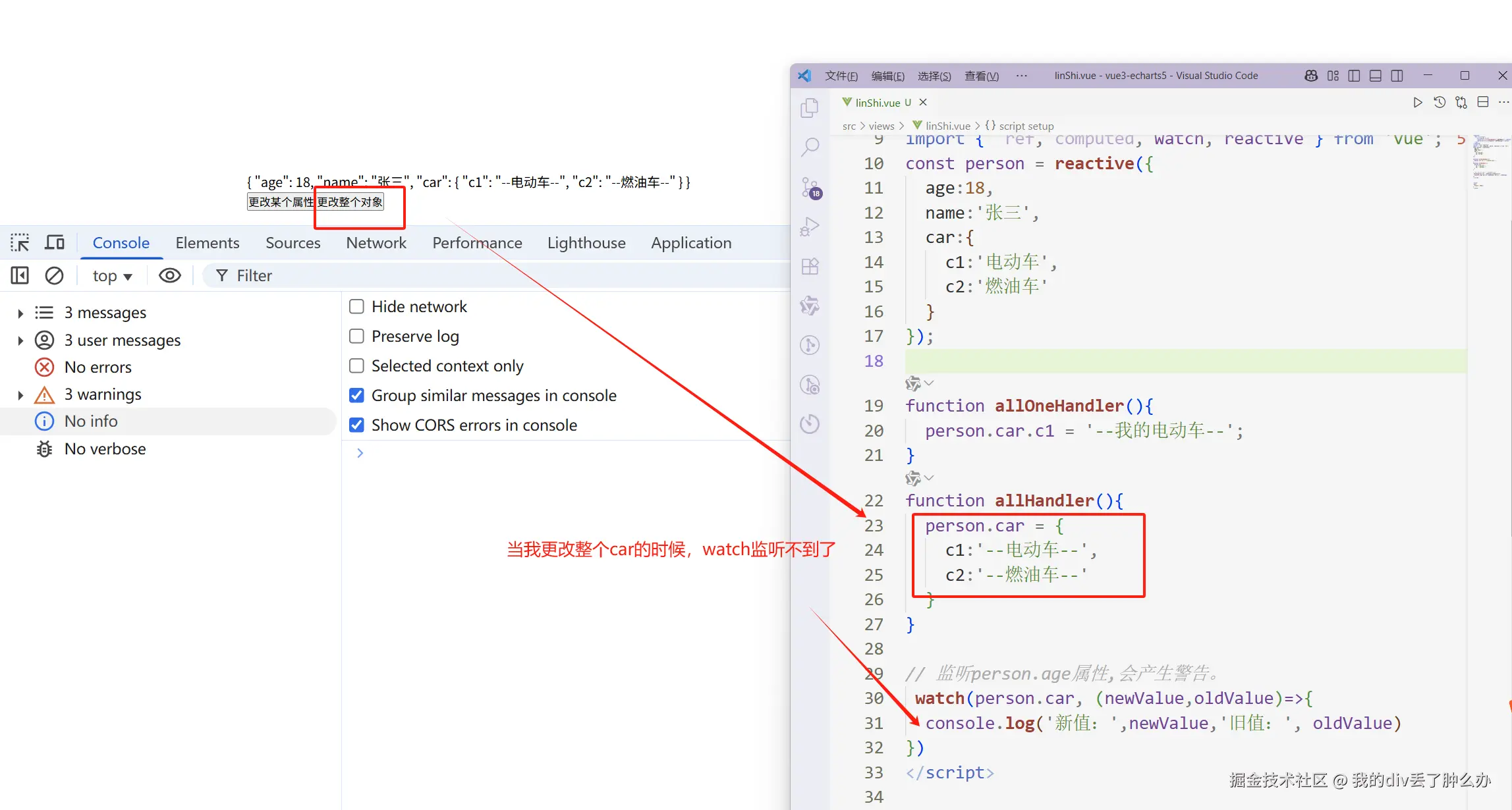 为什么上面的直接更改整个监听对象,监听不到。
为什么上面的直接更改整个监听对象,监听不到。
scss
person.car = {
c1:'--电动车--',
c2:'--燃油车--'
}
watch(person.car,()=>{})因为:当你替换整个car的时候,已经不再是原来的car。因此无法监听到。
怎么让它也可以监听到呢?写成函数形式。
php
const person = reactive({
age:18,
name:'张三',
car:{
c1:'电动车',
c2:'燃油车'
}
});
function allHandler(){
person.car = {
c1:'--电动车--',
c2:'--燃油车--'
}
}
watch(()=>person.car, (newValue,oldValue)=>{
console.log('新值:',newValue,'旧值:', oldValue)
})
写成函数形式,监听整某个具体属性又不行了。
xml
<template>
<div>
<h1>{{ person }}</h1>
<button @click="allHandler">更改car这个对象</button>
<button @click="allOneHandler">更改某个属性</button>
</div>
</template>
<script lang="ts" setup>
import { watch,reactive } from 'vue';
const person = reactive({
age:18,
name:'张三',
car:{
c1:'电动车',
c2:'燃油车'
}
});
function allHandler(){
person.car = {
c1:'--电动车--',
c2:'--燃油车--'
}
}
function allOneHandler(){
person.car.c1 += '--我的电动车--';
}
watch(()=>person.car, (newValue,oldValue)=>{
console.log('新值:',newValue,'旧值:', oldValue)
})
</script>
终极的解决办法
php
const person = reactive({
age:18,
name:'张三',
car:{
c1:'电动车',
c2:'燃油车'
}
});
function allOneHandler(){
person.car.c1 += '--我的电动车--';
}
function allHandler(){
person.car = {
c1:'--电动车--',
c2:'--燃油车--'
}
}
watch(()=>person.car, (newValue,oldValue)=>{
console.log('新值:',newValue,'旧值:', oldValue)
},{ deep: true }) 这样无论是更改整个对象还是对象内部的属性变化。都可以监听到啦。
这样无论是更改整个对象还是对象内部的属性变化。都可以监听到啦。
总结:watch监听reactive/ref定义的内部属性时,监听的属性是对象,推荐写成函数形式,并且开启深度监听。
watch的数据源写成一个数组
有些时候,我们需要监听一个对象中的几个属性或者好几个不同的对象。
这个时候我们可以写成一个数组的形式
xml
<template>
<div>
<h1>{{ person }}</h1>
<button @click="allHandler">更改car这个对象</button>
<button @click="oneNameHandler">更改某个属性name</button>
</div>
</template>
<script lang="ts" setup>
import { watch, reactive } from 'vue';
const person = reactive({
age:18,
name:'张三',
car:{
c1:'电动车',
c2:'燃油车'
}
});
function allHandler(){
person.car = {
c1:'小米Su7',
c2:'小米Yu7'
}
}
function oneNameHandler(){
person.name = '李四';
}
watch(()=>[person.name, person.car.c1], (newValue,oldValue)=>{
console.log('newValue', newValue)
console.log('oldValue', oldValue)
},{
deep:true
})
</script>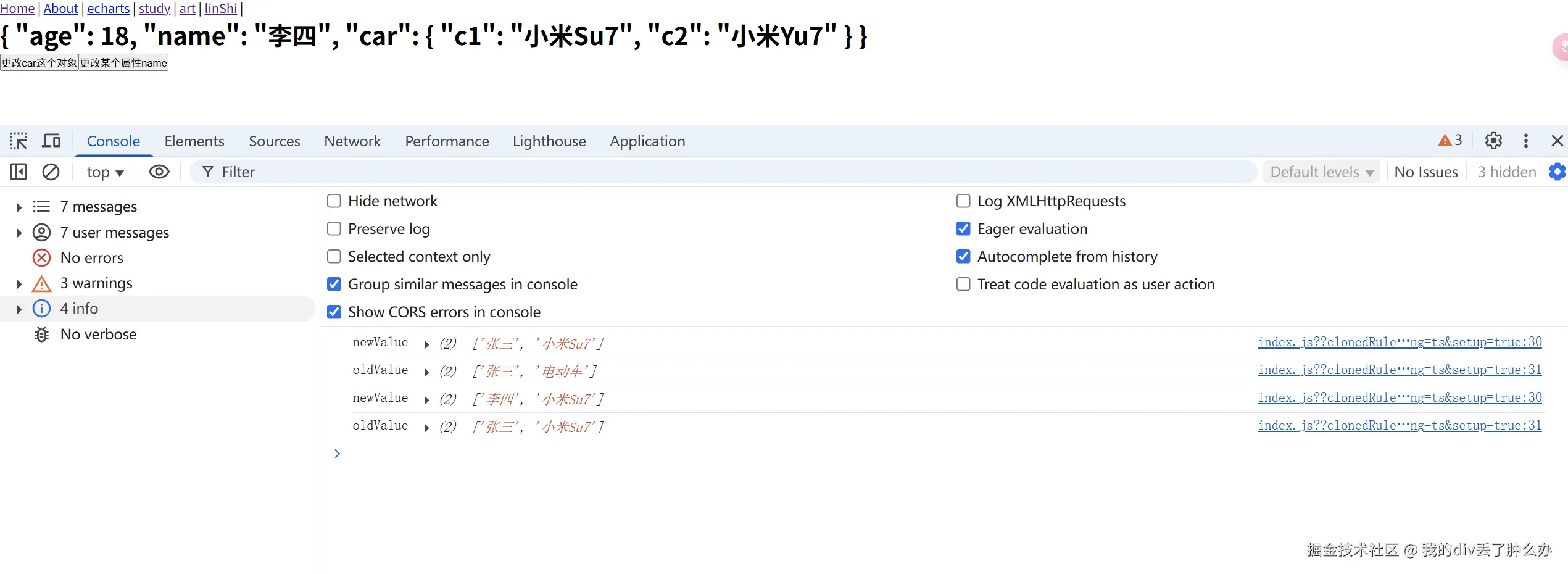
什么时候需要深度监听?
明明人家监听的是地址的变化,结果你想要监听某个值的变化
再次说明:watch为啥新值和旧值一样?
因为监听的是地址,你更改属性时,地址没有发生变化。
Object.assign更改时,也是只更改了属性,并没有产生新的地址。
相当于你新装修房子,你只换了灯,床,房子的地址没有发生变化。
因此:新值和旧值是一样的。
取消watch监听
将watch赋值给一个变量,调用这个变量。就可以停止监听了。
javascript
import { ref, computed, watch } from 'vue';
const age = ref(1);
function changeHandler(){
age.value +=1
}
let stopWatch = watch(age, (newValue,oldValue)=>{
console.log('watch监听到的值新值:',newValue,'旧值:', oldValue)
if(newValue>3){
stopWatch()
}
})
</script>